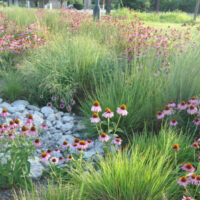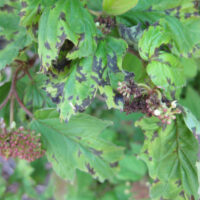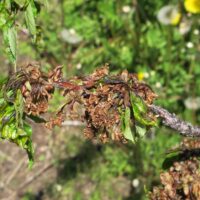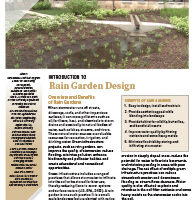 Purdue University - Extension - Forestry and Natural Resources
Purdue University - Extension - Forestry and Natural Resources
Got Nature? Blog
In recognition of Pollinator Week 2024, let’s see what is blooming at Purdue FNR Tippecanoe County property, Martell Forest.
 Wild petunia, Ruellia sp, are several species found in woodland and sunny edge habitats. The blooms do look like the familiar garden petunia, but it is a different genus of plants. I caught small insects inside the flower, evidence of its pollinator value, although I have read the individual flowers may only last one day.
Wild petunia, Ruellia sp, are several species found in woodland and sunny edge habitats. The blooms do look like the familiar garden petunia, but it is a different genus of plants. I caught small insects inside the flower, evidence of its pollinator value, although I have read the individual flowers may only last one day.
 I came upon a unique parasitic plant that does not have chlorophyll or true leaves, but obtains its nutrients by parasitizing oak trees. This is American cancer root, Conopholis americana, also called bear corn, because of the similarity of the plant structure to an ear of corn. Although it lacks chlorophyll, it does possess flowers that propagate the plant.
I came upon a unique parasitic plant that does not have chlorophyll or true leaves, but obtains its nutrients by parasitizing oak trees. This is American cancer root, Conopholis americana, also called bear corn, because of the similarity of the plant structure to an ear of corn. Although it lacks chlorophyll, it does possess flowers that propagate the plant.
 Not far from the cancer root I found fire pink, Silene virginica. This is one flower that would be hard to miss! This is about as red as any native flower encountered in Indiana forests. If you are wondering why pink is in the name instead of red, it is a member of the pink family of plants, which include carnations and a rare prairie relative, royal catchfly. An effort was made a few years ago to make this our state flower, but that has not been acted upon so far.
Not far from the cancer root I found fire pink, Silene virginica. This is one flower that would be hard to miss! This is about as red as any native flower encountered in Indiana forests. If you are wondering why pink is in the name instead of red, it is a member of the pink family of plants, which include carnations and a rare prairie relative, royal catchfly. An effort was made a few years ago to make this our state flower, but that has not been acted upon so far.
 As I headed downhill I came across Virginia spiderwort, Tradescantia virginiana, with beautiful three-petaled violet to blue flowers clustered at the top of the plant. The flowers typically last only a day, but are rapidly replaced by the numerous buds below the current blooms.
As I headed downhill I came across Virginia spiderwort, Tradescantia virginiana, with beautiful three-petaled violet to blue flowers clustered at the top of the plant. The flowers typically last only a day, but are rapidly replaced by the numerous buds below the current blooms.
 Blue-eyed grass, Sisyrinchium sp. was encountered in a grassy area near a tree plantation. This is not a grass but several species that are members of the iris family. The tiny blooms and narrow leaves blend into the grass background.
Blue-eyed grass, Sisyrinchium sp. was encountered in a grassy area near a tree plantation. This is not a grass but several species that are members of the iris family. The tiny blooms and narrow leaves blend into the grass background.
 Some woody plants are blooming in June as well. This is the bell-shaped flower of American persimmon, Diospyros virginiana. Persimmon trees tend to bear either all male or all female flowers on a single tree, but occasionally a tree will have both. Female flowers are solitary on the stems while male flowers tend to be in small clusters.
Some woody plants are blooming in June as well. This is the bell-shaped flower of American persimmon, Diospyros virginiana. Persimmon trees tend to bear either all male or all female flowers on a single tree, but occasionally a tree will have both. Female flowers are solitary on the stems while male flowers tend to be in small clusters.
 The final bloom I have included is rough-leaved dogwood, Cornus drummondii, a shrub relative of the flowering dogwood that provides a white blossom show earlier in the spring. As the name implies, this shrub has leaves with a slightly sandpaper-texture and clusters of small white flowers that are attractive to many pollinators. This blooms later than several other dogwoods, extending the flowering season.
The final bloom I have included is rough-leaved dogwood, Cornus drummondii, a shrub relative of the flowering dogwood that provides a white blossom show earlier in the spring. As the name implies, this shrub has leaves with a slightly sandpaper-texture and clusters of small white flowers that are attractive to many pollinators. This blooms later than several other dogwoods, extending the flowering season.
More about Pollinator Week: this an annual celebration in support of pollinator health that was initiated and is managed by Pollinator Partnership. It is a time to raise awareness for pollinators and spread the word about what we can do to protect them. Pollinators include bees, butterflies, beetles, moths, wasps, hummingbirds, bats, flies, beetles, lizards, rodents and more.
Resources:
USDA Recognizes National Pollinator Week, U.S. Department of Agriculture
Ask an Expert: What’s Buzzing or Not Buzzing About Pollinators, Purdue Extension – Forestry & Natural Resources (FNR) YouTube Channel
Indiana Monarch and Pollinator Conservation website
Protecting Pollinators: Protecting Pollinators in Home Lawns and Landscapes, publication, The Education Store, Purdue Extension’s resource center
Consider Pollinators When Planning Your Garden, Got Nature? Blog, Purdue Extension – FNR
Pollinator Conservation Education, Purdue Entomology
Recommended Indiana-native Plants for Attracting Pollinators (pdf), Purdue Extension – Entomology
Attract Hummingbirds to Your Yard video, Purdue Extension – FNR YouTube Channel
Protecting Pollinators: Biology and Control of Varroa Mites in Bee Hives, The Education Store, Purdue Extension resource center
Gardening for Pollinators, Purdue Garden Articles
Subscribe Purdue Extension-Forestry and Natural Resources YouTube Channel
Lenny Farlee, Extension Forester
Hardwood Tree Improvement and Regeneration Center
Purdue Department of Forestry & Natural Resources
Join alumna Megan Benage, a regional ecologist for the Minnesota Department of Natural Resources, and Bee Redfield, a postgraduate research assistant, as they explore the world of pollinators. They cover the who’s, the what’s and how’s of pollination as well as how you can help bring pollinators to your yard and help the pollinator population in general. They also share about ongoing research and cool projects related to pollinators.
If you have any questions regarding wildlife, trees, forest management, wood products, natural resource planning or other natural resource topics, feel free to contact us by using our Ask an Expert web page.
Resources
Protecting Pollinators: Biology and Control of Varroa Mites in Bee Hives, The Education Store, Purdue Extension resource center
The Complex Life of the Honey Bee: Environmental, Biological, and Chemical Challenges to Colony Health, The Education Store
Youth Pollinator Packet, The Education Store
Pollinator Protection, Website, Purdue Extension
Gardening for Pollinators, Purdue Graden Articles
Megan Benage, Regional Ecologist
Minnesota Department of Natural Resources
Bee Redfield, Postgraduate Research Assistant
Purdue Forestry and Natural Resources
Join Indiana Forestry & Woodland Owners Association (IFWOA) as they celebrate the state’s natural beauty by sharing photos and stories from Carroll Ritter’s book of “Magnificent Trees of Indiana.” They discuss the changes that have occurred over the last two centuries in Indiana’s forests, including the landscape geology and physiography.
Check out the Indiana Forestry & Woodland Association YouTube Channel for videos including: What is IFWOA?; A New Carbon Program for Hardwood Landowners Webinar, Indiana’s Native Orchids, Magnificent Trees of Indiana, Be Tick Aware and much more.
The Indiana Forestry & Woodland Owners Association (IFWOA) was founded in 1977 and is a non-profit organization dedicated to conservation and sustainable management of woodlands in Indiana. IFWOA advocates for scientific best practices for management to achieve objectives of clean water, wildlife habitat, soil protection, native species diversity, timber production, recreation, carbon sequestration and many others.
IFWOA is an affiliate of the National Woodland Owners Association. IFWOA is a partner, collaborator or is represented on leading National and State organizations. These memberships or collaborations are selected to advance Indiana Woodland owner’s interests. IFWOA monitors and influences legislation and economic trends impacting Indiana woodlands and landowners for our members. Membership in IFWOA provides a valuable network linkage to information and resources at the leading edge of science, industry and politics impacting Indiana woodlands.
Resources:
Magnificent Trees of Indiana, Purdue University Press
Forest Improvement Handbook, The Education Store, Purdue Extension’s resource center
Planting Hardwood Seedlings – The Education Store
Ordering Seedlings from the State Forest Nursery System, Got Nature? – Purdue Extension-FNR
Importance of Hardwood Tree Planting – The Education Store, Purdue Extension Resource Center
Forest Improvement Handbook – The Education Store
Designing Hardwood Tree Plantings for Wildlife – The Education Store
ID That Tree – YouTube Playlist
Forest Management for Reptiles and Amphibians: A Technical Guide for the Midwest, The Education Store
Hardwood Ecosystem Experiment – Forest Birds , Purdue Extension – FNR YouTube Channel
Managing Woodlands for Birds , Purdue Extension – FNR YouTube Channel
Sustaining Our Oak-Hickory Forests , Purdue Extension – FNR YouTube Channel
Ask the Expert: Hardwood Ecosystem Experiment – Birds and Salamander Research, Purdue Extension – FNR
Subscribe to Purdue Extension-FNR YouTube Channel
Liz Jackson, Engagement Lead
Indiana Forestry & Woodland Association
In this webinar, hosted by Indiana Forestry & Woodland Owners Association (IFWOA), presenter LeAnne Barta of Indiana Lyme Connect shares strategies for preventing tick bites and discuss the ticks found in Indiana, their life stages, and symptoms of tick-borne illnesses like Lyme disease.
Check out the Indiana Forestry & Woodland Association YouTube Channel for videos including: What is IFWOA?; A New Carbon Program for Hardwood Landowners Webinar, Indiana’s Native Orchids, Magnificent Trees of Indiana, Observing Seasonal Changes in Nature and much more.
The Indiana Forestry & Woodland Owners Association (IFWOA) was founded in 1977 and is a non-profit organization dedicated to conservation and sustainable management of woodlands in Indiana. IFWOA advocates for scientific best practices for management to achieve objectives of clean water, wildlife habitat, soil protection, native species diversity, timber production, recreation, carbon sequestration and many others.
IFWOA is an affiliate of the National Woodland Owners Association. IFWOA is a partner, collaborator or is represented on leading National and State organizations. These memberships or collaborations are selected to advance Indiana Woodland owner’s interests. IFWOA monitors and influences legislation and economic trends impacting Indiana woodlands and landowners for our members. Membership in IFWOA provides a valuable network linkage to information and resources at the leading edge of science, industry and politics impacting Indiana woodlands.
Resources:
Find an Indiana Professional Forester, Indiana Forestry & Woodland Owners Association (IFWOA)
Purdue Arboretum Explorer
Native Trees of the Midwest, The Education Store
Shrubs and Woody Vines of Indiana and the Midwest, The Education Store
Investing in Indiana Woodlands, The Education Store
Forest Improvement Handbook, The Education Store
ID That Tree, Purdue Extension-Forestry & Natural Resources (FNR) YouTube playlist
Woodland Management Moment , Purdue Extension-FNR YouTube playlist
Liz Jackson, Engagement Lead
Indiana Forestry & Woodland Association
Illinois-Indiana Sea Grant Newsroom: During large rainstorms, many Illinois residents brace themselves for flooding in their basements, streets and neighborhoods. A new online tool, Illinois Groundwork, provides communities and stormwater professionals with resources on green stormwater infrastructure, which provides a way for rain to be absorbed into soil where it lands.
Green stormwater infrastructure offers a way to enhance traditional or “grey” infrastructure using a rain garden or permeable pavement but this approach doesn’t always work as well as it might. Improving access to, and use of, data, research and other resources can help increase the effectiveness of green infrastructure in addressing stormwater management challenges.
“The University of Illinois not only has relevant research and data across many departments, but also real-world examples of successful green infrastructure, along with other extension and education tools, such as the Red Oak Rain Garden,” said C. Eliana Brown, University of Illinois Extension stormwater specialist. “This new tool brings these resources together, providing a robust platform to access green infrastructure knowledge.”
For full article and videos please visit Illinois Groundwork provides a rich supply of green infrastructure resources – IISG
About IISG: These are trying times for the environment. Climate change and other concerns such as population growth, aquatic invasive species, contaminated waters, and loss of natural habitat, the southern Lake Michigan region faces many challenges. Illinois-Indiana Sea Grant (IISG), with its unique mandate to bring the latest science to those who can best use the information, serves a critical role in empowering people to solve problems in sustainable ways. The program is funded through National Oceanic and Atmospheric Administration (NOAA), the University of Illinois and Purdue University, but IISG also works in partnerships with key organizations, institutions, and agencies in the region to reach more audiences and multiply opportunities for success. IISG brings together scientists, educators, policy makers, community decision makers, outreach specialists, business leaders, and the general public to work towards a healthy environment and economy.
Resources
Center For Great Lakes Literacy (CGLL), Website
Ask An Expert: Hot and Cold, Video, Purdue Extension – Forestry and Natural Resources YouTube channel
Informing the Development of the Great Lakes Region Decision Support System, The Education Store, Purdue Extension’s resource center
Urban Best Management & Low Impact Development Practices, The Education Store
Improving Water Quality Around Your Farm, The Education Store
New website: Eat Midwest Fish, Got Nature? Blog, Purdue Extension – Forestry and Natural Resources (FNR)
Scientists bring the Great Lakes to students learning from home, Got Nature? Blog
Adaptations for Aquatic Amphibians Activity 2: Water Quality Sneak Peak, Purdue Nature of Teaching
Illinois-Indiana Sea Grant (IISG)

Bacterial leaf spots are often angular with chlorotic halos, as seen on this high bush-cranberry. Photo by Janna Beckerman.
Purdue Landscape Report: Pseudomonas syringae pv. syringae is an opportunistic bacterial pathogen that attacks a diversity of woody ornamental plants. The bacteria cause flower blights, cankers, shoot blights, and diebacks.
Symptoms
Symptoms often begin as expanding leaf spots. On lilac and viburnum, small spots expand to irregularly shaped brown lesions with yellow halos (Fig. 1). For most other hosts (cherry, pear, basswood, dogwood, hydrangea, high bush-cranberry, mountain-ash), infected leaves turn reddish brown or black and usually remain on the branch after they die (Fig. 2). As the bacteria spread into woody tissue, dark, sunken sections of the stem (cankers) expand, working their way back toward the trunk from infected leaves and flowers. Leaves attached to a cankered branch will wilt while the tip of the affected branch curls and droops like a shepherd’s crook (Fig. 3). Cloudy droplets of sticky fluid (ooze) may accumulate on leaf tips, leaf surfaces, stems, and even infected fruit.
Image of infected flowers result in blossom blast.
Figure 2. Infected flowers result in blossom blast. The continued growth of the bacteria can result in cankering and blight. Photo by George Sundin.
Life Cycle
The bacteria overwinter and persist in cankers, along with asymptomatic bud and twig tissue. In presence of water and warming temperatures, bacteria multiply and may ooze from infected tissue. Wind-driven rain, insect, or mechanical pruning spread Pseudomonas. Bacteria enter the plant through flowers or injury.
Management
All bacterial pathogens, including Pseudomonas, invade flowers or wounded tissue. To prevent or minimize the risk of infection:
- Use disease-free plants and budwood.
- Prune in the late winter/early spring.
- When pruning, do not mix pruning to shape woody ornamentals with pruning to manage disease.
- When pruning to remove infected shoots, be sure to disinfect shears between plants.
- Minimize overhead irrigation when possible to minimize splashing and pathogen spread.
- Avoid over-fertilization practices that drive excess succulent growth.
- Avoid late season fertilization practices that prevent plants from achieving timely dormancy and promote freeze damage and/or winter injury (Fig. 4).
- Choose zone appropriate plants to avoid freeze damage and/or winter injury.
- Choose disease resistant plants, when available. The following lilac varieties were found to be resistant over a four-year trial: Donald Wyman, Royalty, Superba, Miss Kim, Edmund Boisier, Victor Lemoine, Dwarf Korean, Mme. Antoine Buchner Isabella, Sensation, Anna Amhof, Krasavitska Moskvy, Michael Buchner, and Alphonse Lavallée.
Foliar sprays of some copper-based bactericides (e.g., Camelot, Kocide, and Nu-Cop) were found to reduce disease incidence in trials on lilac (Vey and Palmer, 2018). Avoid using copper under cool, humid conditions to reduce the risk of phytotoxicity and damaging plants. Copper resistant populations of Pseudomonas syringae have been reported in other crops (vegetables, stone fruit). Products containing acibenzolar have provided inconsistent control in multiple trials but is labeled for use. Use of quaternary-ammonium disinfestants (KleenGrow) have been found to reduce bacterial populations and disease incidence and should be considered as part of any rotation with copper products. Due to the diversity of copper products, be sure to test for phytotoxicity issues prior to large scale treatment of crops.
To view this article and other Purdue Landscape Report articles, please visit Purdue Landscape Report.
Subscribe and receive the newsletter: Purdue Landscape Report Newsletter.
Resources:
The Purdue Landscape Report
Purdue Landscape Report Facebook Page
Find an Arborist website, Trees are Good, International Society of Arboriculture (ISA)
Phytophthora Diseases in Ornamentals, The Education Store, Purdue Extension’s resource center
Root Rot in Landscape Plants, The Education Store
Symptoms and Signs for Plant Problem Diagnosis, The Education Store
Tree Defect Identification, The Education Store
Tree Pruning Essentials, Publication & Video, The Education Store
Shrubs and Woody Vines of Indiana and the Midwest, The Education Store
Tree Risk Management, The Education Store
Equipment Damage to Trees, Got Nature? Blog
Tree wounds and healing, Got Nature? Blog
ID That Tree, Purdue Extension-Forestry & Natural Resources (FNR) YouTube playlist
Southwest Damage, Scalding, or Frost Cracking – Landscape Report
Subscribe to Purdue Extension-FNR YouTube Channel
Janna Beckerman, Professor of Plant Pathology
Purdue Department of Botany
A rain garden is a green infrastructure project that can improve the quality of stormwater, minimize pollution, and enhance biodiversity and pollinator habitat. Purdue, Iowa State and Illinois-Indiana Sea Grant researchers explain how to site, size, design, install and maintain a rain garden, and provide advice on plant selection, too.
When stormwater runs off streets, driveways, roofs, and other impervious surfaces, it can move pollutants such as oil, fertilizers, heat, and chemicals to storm drains and eventually to natural bodies of water, such as lakes, streams, and rivers. These natural water sources are valuable resources for recreation, irrigation, and drinking water. Green infrastructure projects, such as rain gardens, can improve the quality of stormwater, reduce flooding, minimize pollution, enhance biodiversity and pollinator habitat, and create educational and recreational opportunities.
Green infrastructure includes a range of practices that allows stormwater to infiltrate into the soil or be stored for later use, thereby reducing flows to sewer systems and surface waters (U.S. EPA, 2022). A rain garden is one such practice. It is a smallscale landscape feature planted with native shrubs, perennial plants, or flowers in a shallow depression. It captures and stores runoff, allowing it to slowly infiltrate into the soil. At the property scale and when properly located, rain gardens lessen erosion in steeply sloped areas, reduce the potential for water to flow into basements, and minimize ponding in areas with poor drainage. The net effect of multiple green infrastructure practices can reduce streambank erosion and downstream flooding as stream flows decrease. Water quality is also affected as plants and microbes in the soil filter nutrients and some heavy metals as the stormwater soaks into the soil.
To receive the free download for the Introduction to Rain Garden Design please visit The Education Store.
Resources:
Community Development, Purdue Extension Program
Environmental Planning in Community Plans, The Education Store, Purdue Extension’s resource center
Enhancing the Value of Public Spaces: Creating Healthy Communities, The Education Store
Conservation through Community Leadership, The Education Store
Tree Installation: Process and Practices, The Education Store
Planting Forest Trees and Shrubs in Indiana, The Education Store
Planting Your Tree Part 1: Choosing Your Tree, Video, Purdue Extension – Forestry and Natural Resources YouTube Channel
Tipping Point Planner
Sustainable Communities Extension Program
Subscribe – Purdue Extension – Forestry and Natural Resources YouTube Channel
Purdue Extension-Forestry and Natural Resources Calendar, workshops and Conferences
Kara A Salazar, Sustainable Communities
Purdue Community Development Extension Specialist
Sara Winnike McMillan, Associate Professor
Purdue University
Payton Ginestra, Natural Resources and Environmental Science
Purdue University
Laura Esman, Water Quality Program Coordinator
Purdue University
John Orick, Purdue Extension Master Gardener State Coordinator
Purdue University
Kara Salazar has been promoted to Assistant Program Leader for Purdue Extension Community Development. She has served in this role part-time but will now be fully dedicated to this program area. Kara will maintain her 25% appointment with Illinois-Indiana Sea Grant (IISG) and serve on the Agriculture Natural Resources (ANR) Extension Advisory Committee. She will still be located in the Forestry Building (FORS 308) and affiliated with the Department of Forestry and Natural Resources (FNR).
Working with multidisciplinary teams, Kara oversees the development and delivery of programs to support environmental planning, community development, and sustainable development strategies in communities across Indiana and the Great Lakes states. Kara provides leadership to the Purdue Extension Community Development Program and serves as a liaison between Illinois-Indiana Sea Grant and Purdue Extension.
Kara has a B.S. in public affairs and environmental science and a M.P.A. in natural resources management and nonprofit management from the Indiana University School of Public and Environmental Affairs. She also received a M.S. Ed . degree from the IU School of Education at Indiana University-Purdue University Indianapolis (IUPUI) with concentrations in community building and science education. Additionally, she is a Ph.D. candidate in Natural Resources Social Science at Purdue University. Kara is a member of the American Institute of Certified Planners (AICP), a Climate Change Professional (CC-P), and a Professional Community and Economic Developer (PCED) with credentials from LEED AP Neighborhood Development, the National Green Infrastructure Certification Program (NGICP), and the National Charrette institute.
Congratulations to Kara in her new position as she continues to move Purdue Extension and IISG forward with her expertise and team building.
Check out Kara’s lead role in the following programs and learn about the vast resources available:
Purdue Extension Community Development – strengthens the capacity of local leaders, residents, businesses, and organizations to build resilient, inclusive and sustainable communities through research-based resources and processes. Examples of a few of the programs and resources available include: Leadership and Civic Engagement, Community and Organizational Planning, Economic and Business Development.
Illinois-Indiana Sea Grant (IISG) – utilizes research, outreach, and education to bring the latest science to Great Lakes communities and their residents. By connecting decision-makers with science, we help strengthen and preserve ecosystems and communities in southern Lake Michigan and beyond.
Agriculture & Natural Resources (ANR), Purdue Extension – ANR Educators serve as research based, unbiased information source for county and state constituents on a variety of topics including: crops, ag business, livestock, natural resource, horticulture, small farms, urban ag, pesticide use, and land conservation.
Purdue Extension – a leader in providing relevant, high-impact educational programs that transform he lives and livelihoods of individuals and communities in Indiana and the world. Purdue Extension – Forestry & Natural Resources (FNR) is a branch of the Cooperative Extension Service/Purdue Extension. FNR Extension provides resources for aquaculture, fish management, urban and forestry management, natural re source planning, wildlife, and sustainable biomaterials. We encourage you to browse, download free publications, utilize our Ask an Expert, subscribe to Got Nature? newsletter and view upcoming workshops.
Sustainable Communities Extension Program (SCEP) – provides multidisciplinary teams focusing in the following areas: Placemaking and Enhancing the Value of Public Spaces; Land use Planning Education; Green Infra structure; Community Development; American Citizen Planner; Facilitation and Strategic Planning; Conservation Through Community Leadership; Rainscaping Education and Tipping Point Planner.
More Resources including Kara’s publications and videos:
Implementation Examples of Smart Growth Strategies in Indiana, The Education Store, Purdue Extension’s resource center
Conservation Through Community Leadership, The Education Store
Climate Change and Sustainable Development, The Education Store
Climate Change: Are you preparing for it?, The Education Store
Tipping Point Planner, The Education Store
Enhancing the Value of Public Spaces, The Education Store
Enhancing the Value of Public Spaces: Creating Healthy Communities, The Education Store
One Water Approach to Water Resources Management, The Education Store
Rainscaping Education Program, Purdue Extension
Conservation Through Community Leadership, Sustainable Communities Extension Program (SCEP)
Community Planning Playlist, Purdue Extension-Forestry & Natural Resources (FNR) YouTube Channel
Rainscaping and Rain Gardens, Purdue Extension YouTube Channel
Conservation through Community Leadership, Purdue Extension You Tube Channel
Enhancing the Value of Public Spaces Program, Purdue Extension YouTube Channel
Tipping Point Planner, Purdue Agriculture YouTube Channel
Indiana Creek Watershed Project – Keys to Success, Partnerships and People, Purdue Extension You Tube Channel
Subscribe to Purdue Extension – Forestry and Natural Resources YouTube Channel
Diana Evans, Extension and Web Communication Specialist
Purdue University Department of Forestry and Natural Resources
Much like the winter season, which has produced warm and relatively wet conditions across most of the state, the Climate Prediction Center is calling for continued above average temperatures and precipitation for Indiana this spring.
 The March, April and May weather outlook is influenced again by the continuing La Nina conditions in the El Nino Southern Oscillation (ENSO). Unlike previous seasons, models are showing growing certainty that La Nina conditions will give way to ENSO-neutral conditions during the end of springtime. This would conclude La Nina’s current event lasting over two years.
The March, April and May weather outlook is influenced again by the continuing La Nina conditions in the El Nino Southern Oscillation (ENSO). Unlike previous seasons, models are showing growing certainty that La Nina conditions will give way to ENSO-neutral conditions during the end of springtime. This would conclude La Nina’s current event lasting over two years.
The majority of the wetter than average predictions are likely to occur early in March and potentially through April. The end of La Nina would remove certainty of increased wet or dry conditions in May. Potential precipitation anomalies are predicted to be at least one inch greater than average precipitation across the state, with higher amounts in the south.
Temperature is also affected by the removal of La Nina, with the current warming signal weakening toward the end of spring. During early springtime, the glut of the warmth over the southeastern U.S. will spread northward into Indiana. Temperatures are too close to call for warmth or coolness in northwest Indiana, a line north of Terre Haute to South Bend. Predicted temperature anomalies are very low across the state, with a warming anomaly of 0.2 degrees Fahrenheit in the southern part of the state and 0.05 degrees Fahrenheit in the north.
Any areas of the state currently in abnormally dry conditions in the U.S. Drought Monitor are likely to be removed in the near future as these predictions play out. The Climate Prediction Center does not expect drought development anywhere in Indiana over the next three months.
For those with intentions of planting outdoors, lack of drought is good. However, planting windows may be shorter in the early spring period.
Resources:
Climate Change and Sustainable Development, The Education Store, Purdue Extension’s resource center
Climate Change: Are you preparing for it?, The Education Store
Conservation through Community Leadership, The Education Store
Indiana Prepared (IN PREPared), Purdue Extension
Trees Stressed Due to Drought? Know the Signs and What to Do, Purdue Extension – Forestry and Natural Resources (FNR) Got Nature? Blog
Drought? Don’t forget the trees!, The Education Store
Hans Schmitz, Climate Smart Agriculture and Soil Health Coordinator
Purdue Extension – Agriculture & Natural Resources
The Purdue Rainscaping Education Program introduces two new videos as they continue to provide training and resources on rainscaping practices that can be installed in residential settings or small-scale public spaces projects.
Rainscaping and Rain Gardens
Rainscaping is a combination of sustainable landscape design and management practices that prevents polluted runoff from reaching water bodies — directing stormwater to be absorbed by plants and soils.
Rainwater Harvesting with Cisterns
This video demonstrates how rainwater can be harvested with cisterns for future use in your landscaping and gardens.
Rainscaping is a combination of sustainable landscape design and management practices that prevents polluted runoff from reaching water bodies — directing stormwater to be absorbed by plants and soils. Learn more about rainscaping and demo rain gardens at: Purdue Rainscaping Education Program.
Resources:
What is Rainscaping? Purdue Rainscaping Education Program Video, Purdue Extension
Sustainable Communities Extension Program, Purdue Extension
Q&A About Drainage Water Recycling for the Midwest, The Education Store, Purdue Extension resource center
Rainscaping Playlist, Purdue Extension – Forestry and Natural Resources (FNR) YouTube Channel
Ask an Expert: Rainscaping, Purdue Extension – FNR YouTube Channel
Rain Gardens Go with the Flow, Indiana Yard and Garden, Purdue Horticulture
Become a Purdue Master Gardener, The Education Store
Master Gardeners Program
Plan Today For Tomorrow’s Flood, The Education Store
John Orick, Purdue Master Gardener State Program Coordinator
Department of Horticulture & Landscape Architecture
Kara Salazar, Assistant Program Leader and Extension Specialist for Sustainable Communities
Department of Forestry and Natural Resources
Recent Posts
- Celebrate Pollinator Week With Flowers of June Tour
Posted: June 20, 2024 in Forestry, Gardening, Wildlife - Ask An Expert: What’s Buzzing or Not Buzzing About Pollinators, Webinar
Posted: July 4, 2023 in Forestry, Gardening, How To, Plants, Wildlife - Magnificent Trees of Indiana Webinar
Posted: May 12, 2023 in Forestry, Forests and Street Trees, Gardening, Got Nature for Kids, Urban Forestry, Webinar, Woodlands - Be Tick Aware: Lyme Disease & Prevention Strategies Webinar
Posted: May 11, 2023 in Alert, Forestry, Forests and Street Trees, Gardening, How To, Urban Forestry, Webinar, Wildlife, Woodlands - Illinois Groundwork provides a rich supply of green infrastructure resources – IISG
Posted: in Gardening, Land Use, Plants, Wildlife - Pseudomonas syringae pv. syringae on lilac and other woody ornamentals – Landscape Report
Posted: May 3, 2023 in Forestry, Forests and Street Trees, Gardening, How To, Plants, Safety, Urban Forestry, Woodlands - Publication-Introduction to Rain Garden Design
Posted: April 24, 2023 in Forestry, Gardening, How To, Plants - Kara Salazar Promoted to Aid in Leading Community Development
Posted: March 27, 2023 in Aquaculture/Fish, Aquatic/Aquaculture Resources, Gardening, How To, Land Use, Natural Resource Planning - Warm, wet spring predicted for Indiana
Posted: March 17, 2023 in Drought, Forestry, Forests and Street Trees, Gardening, Plants, Urban Forestry, Woodlands - Purdue Rainscaping Education Program Introduces Two New Videos
Posted: February 7, 2023 in Gardening, How To, Natural Resource Planning
Archives
Categories
- Alert
- Aquaculture/Fish
- Aquatic/Aquaculture Resources
- Ask the Expert
- Christmas Trees
- Community Development
- Disease
- Drought
- Forestry
- Forests and Street Trees
- Gardening
- Got Nature for Kids
- Great Lakes
- How To
- Invasive Animal Species
- Invasive Insects
- Invasive Plant Species
- Land Use
- Natural Resource Planning
- Nature of Teaching
- Plants
- Podcasts
- Ponds
- Publication
- Safety
- Spiders
- Timber Marketing
- Uncategorized
- Urban Forestry
- Webinar
- Wildlife
- Wood Products/Manufacturing
- Woodland Management Moment
- Woodlands


